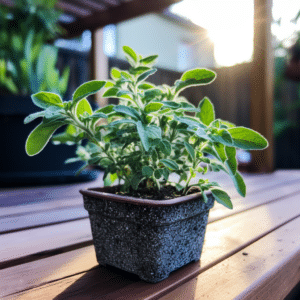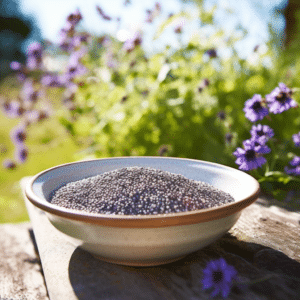Chia seeds have gained immense popularity in recent years due to their numerous health benefits and versatility in cooking. Whether you want to grow chia seeds for personal consumption or as a lucrative business venture, this ultimate guide will provide you with all the information you need to grow healthy and abundant chia plants. From understanding the basics of chia seeds to harvesting and storing them, we will take you through the entire process step by step.
Understanding the Basics of Chia Seeds

Before diving into the cultivation process, it’s crucial to understand the nutritional value and origin of chia seeds. These tiny seeds are packed with essential nutrients such as omega-3 fatty acids, fiber, protein, and antioxidants. Consuming chia seeds regularly can contribute to overall well-being and promote heart health. Native to Mexico and parts of Central America, chia seeds have a rich history dating back to ancient civilizations like the Aztecs and Mayans.
Chia seeds have been used for centuries as a source of sustenance and vitality. The Aztecs and Mayans revered these seeds for their ability to provide long-lasting energy, making them a valuable food source during times of scarcity. They recognized the immense nutritional value of chia seeds and incorporated them into their daily diet.
One of the key reasons why chia seeds are highly regarded is their omega-3 fatty acid content. These essential fatty acids are crucial for brain health and reducing inflammation in the body. By consuming chia seeds, you can easily meet your daily recommended intake of omega-3 fatty acids, supporting cognitive function and overall well-being.
Nutritional Value of Chia Seeds
Chia seeds are true nutritional powerhouses. With just a single ounce of chia seeds, you can achieve your daily recommended intake of several key nutrients. They are an excellent source of omega-3 fatty acids, which are essential for brain health and reducing inflammation in the body. Chia seeds are also rich in fiber, providing a significant boost to digestive health and promoting regular bowel movements.
In addition to omega-3 fatty acids and fiber, chia seeds are also packed with protein. This makes them an excellent choice for individuals following a plant-based diet or looking to increase their protein intake. The protein found in chia seeds contains all nine essential amino acids, making it a complete protein source.
Furthermore, chia seeds are abundant in antioxidants. These powerful compounds help protect the body against oxidative stress and free radicals, which can contribute to chronic diseases and premature aging. By incorporating chia seeds into your diet, you can enhance your body’s defense against harmful molecules and promote overall health.
Origin and History of Chia Seeds
Chia seeds have a fascinating cultural and historical background. The ancient civilizations of Mexico and Central America recognized the immense nutritional value of chia seeds and used them as a dietary staple. These seeds were prized for their ability to provide sustainable energy, making them ideal for long journeys and as a food source during times of scarcity. Today, chia seeds continue to be appreciated for their nutritional benefits and versatility in culinary applications.
The Aztecs and Mayans cultivated chia seeds as early as 3500 BC. They understood the importance of these seeds in their diet and even used them as an offering in religious ceremonies. Chia seeds were considered a symbol of strength and endurance, and warriors would consume them before battles to boost their energy levels and stamina.
Chia seeds were so highly valued that they were used as a form of currency in ancient times. They were often traded for other goods and commodities, highlighting their significance in the daily lives of these civilizations. The popularity of chia seeds spread, and they became a staple food not only in Mexico and Central America but also in other parts of the world.
In modern times, chia seeds have gained popularity as a superfood due to their exceptional nutritional profile. They are incredibly versatile and can be incorporated into various dishes, including smoothies, puddings, baked goods, and salads. Whether you’re looking to boost your nutrient intake or add a delightful crunch to your meals, chia seeds are a fantastic addition to any diet.
Preparing for Chia Seed Cultivation
Successful chia seed cultivation starts with careful preparation of the soil and understanding the ideal climate conditions. Let’s explore the key factors that contribute to a thriving chia garden.
Choosing the Right Soil
Chia plants prefer well-drained soil that is rich in organic matter. Sandy loam or loamy soil types are ideal for chia cultivation. Before planting, ensure that the soil is loose and free of any debris or weeds that may hinder seed growth. Conduct a soil test to determine the soil’s pH level and make adjustments if necessary. Generally, chia plants thrive in slightly acidic to neutral soil with a pH range of 6 to 7.
Ideal Climate Conditions for Chia Seeds
Chia seeds are highly adaptable and can be cultivated in a variety of climates. However, they thrive in regions with warm temperatures and moderate rainfall. Ideally, the average temperature should range between 70 to 85 degrees Fahrenheit (21 to 29 degrees Celsius). It’s also important to ensure that chia plants receive ample sunlight, as they require at least six to eight hours of direct sunlight per day.
The Planting Process

Now that you have prepared the soil and understand the climate requirements, it’s time to delve into the planting process. Proper timing and technique are essential for a successful chia seed plantation.
When to Plant Chia Seeds
The best time to plant chia seeds is during the spring season when the soil temperature reaches a consistent minimum of 60 degrees Fahrenheit (15 degrees Celsius). Avoid planting too early, as cold temperatures can hinder germination and stunt plant growth. By waiting for the soil to warm up, you can ensure optimal conditions for your chia plants to thrive.
How to Plant Chia Seeds
Before sowing the chia seeds, ensure that the soil is well-prepared and free of any obstructions. Gently rake the soil to create a fine and smooth surface. To distribute the seeds evenly, mix them with a light layer of soil or sand. Sow the seeds at a depth of approximately 1/4 inch (0.6 cm) and maintain a spacing of 12 to 18 inches (30 to 46 cm) between each seed. Lightly water the soil after planting to provide moisture for germination.
Caring for Your Chia Plants
Once the chia seeds have germinated and sprouted, it’s crucial to provide the necessary care to ensure the healthy growth of your plants. Proper watering, fertilization, and pest control are essential aspects of chia plant care.
Watering and Fertilizing Chia Plants
Chia plants require consistent moisture throughout their growth cycle. Aim to keep the soil consistently moist, but not waterlogged, to promote healthy root development. Regularly check the moisture level of the soil and adjust watering as needed. It’s important to note that chia plants are drought-tolerant, but extended periods without water can negatively impact their overall health. Fertilize your chia plants every four to six weeks with a balanced organic fertilizer to provide essential nutrients.
Dealing with Pests and Diseases
Chia plants are generally resistant to pests and diseases. However, it’s essential to monitor them regularly for any signs of infestation or damage. Common pests that may affect chia plants include aphids, cutworms, and grasshoppers. Applying organic insecticides or using natural pest control methods can help mitigate these issues. Additionally, practicing crop rotation and providing adequate spacing between plants can minimize the risk of disease outbreaks.
Harvesting and Storing Chia Seeds

After months of caring for your chia plants, it’s time to reap the fruits of your labor. Harvesting and storing chia seeds properly will ensure their quality and longevity.
When and How to Harvest Chia Seeds
Chia plants typically reach maturity after 90 to 100 days from the date of planting. To determine if the seeds are ready for harvest, inspect the flower spikes. Once the flowers have dried and turned brown, it’s time to harvest. Cut the spikes carefully and place them in a paper bag or container. Allow the seed heads to dry completely before gently rubbing them to release the seeds.
Proper Storage Techniques for Chia Seeds
To maintain the freshness and nutritional value of chia seeds, store them in an airtight container in a cool, dry place. Avoid exposure to sunlight, heat, and moisture, as these elements can degrade the seeds’ quality. Properly stored chia seeds can stay fresh for up to two years, ensuring that you have a continuous supply for your culinary needs and nutritional benefits.
Now that you have all the necessary information, it’s time to embark on your chia seed cultivation journey. By following these guidelines, you can experience the joy of growing your own chia plants and enjoy the numerous benefits they provide. Happy chia plant cultivation!
